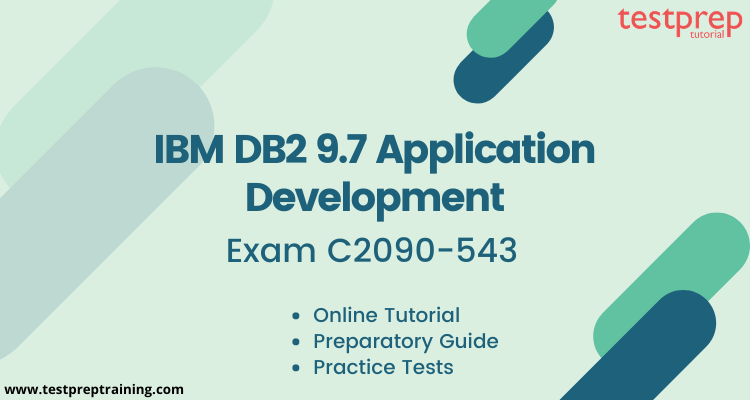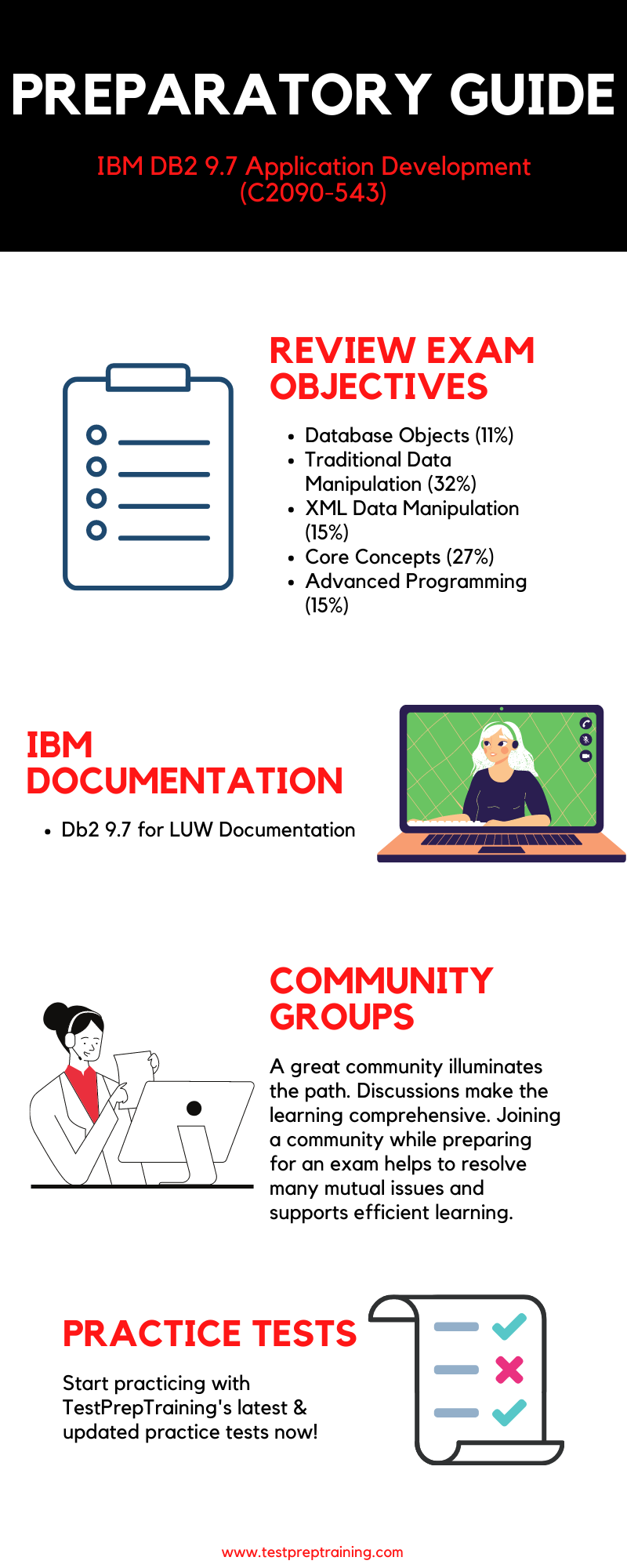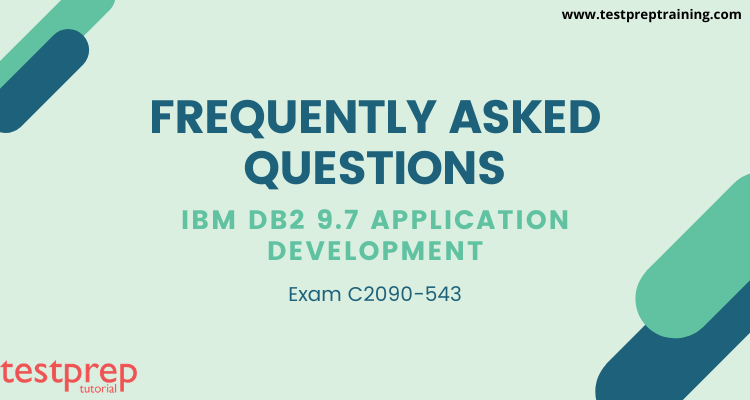(C2090-543) IBM DB2 9.7 Application Development

The IBM DB2 9.7 Application Development (C2090-543) exam certifies that the successful candidate has important knowledge, skills, and abilities necessary to design, build, execute, and deploy DB2 9.7 database applications.
Significant experience with intermediate or advanced level skills in developing applications that interact with DB2 databases. This individual has strong skills in DB2 SQL and in database application development concepts.
Exam Target Audience
The IBM DB2 Application Development certification is mainly targeted to those candidates who want to build their career in IBM Data and AI – Platform Analytics domain. The IBM Certified Application Developer – DB2 9.7 for Linux, Unix, and Windows exam verifies that the candidate possesses the fundamental knowledge and proven skills in the area of IBM DB2 Application Development.
Exam details
| Exam Name | IBM DB2 9.7 Application Development |
| Exam Code | C2090-543 |
| WorldPartner Code | 08002204 |
| Exam Partner | Pearson VUE |
| Number of Questions | 60 |
| Exam Duration | 90 minutes |
| Passing Score | 36 correct answers out of 60 questions |
| Exam Language | English |
| Exam Format | MCQ’s |
| Exam Fees | US$200 |
Exam Retake Policy
If you are not able to make it in the first attempt, there is no waiting requirement before the second attempt. However, you may not take the same exam more than twice within any 30 days of time. The second attempt requires repayment of the fees.
C2090-543 – Frequently Asked Question’s
To get all of your queries regarding the C2090-543 exam resolved, visit: (C2090-543) IBM DB2 9.7 Application Development: FAQ’s
Course Outline
The Exam C2090-543 outlines the following topics:
Section 1 – Database Objects (11%)
- Demonstrate knowledge of naming conventions of DB2objects
- Aliases
- Views
- Tables
- Describe when to use SQL routines, functions and modules
- How to use DB2’s built-in routines
- Functions
- Stored procedures
- Demonstrate knowledge of data types
- Integer
- Floating point
- Strings
- Date/time
- LOBs
- XML data type
Section 2 – Traditional Data Manipulation (32%)
- Demonstrate knowledge of authorities needed to access data in an application
- Describe the differences between dynamic and static SQL
- Demonstrate knowledge of how to query databases across multiple tables and views
- Given a scenario, demonstrate knowledge of changing data
- Insert
- Update
- Delete
- Demonstrate knowledge of cursors
- Types of cursors
- Read-only
- Updatable
- Scrollable
- Scope of cursors
- Create and manipulate cursors
- Given a scenario, demonstrate the ability to manipulate largeobjects
- Locators
- Demonstrate the ability to manage a unit of work
- Isolation levels
- COMMIT
- ROLLBACK
- SAVEPOINT
Section 3 – XML Data Manipulation (15%)
- Given a scenario, demonstrate knowledge of XML schemavalidation
- XML schema evolution
- Demonstrate the ability to use XML functions
- xmlparse
- Whitespace handling
- XMLSERIALIZE
- XMLTRANSFORM
- Functions for preparing XML documents fromrelational data
- Given a scenario, demonstrate knowledge of how to use XQuery expressions and evaluate the results
- Given a scenario, describe how to construct queries that retrieve both traditional and XML data
Section 4 – Core Concepts (27%)
- Describe how to bind and rebind a package
- Given a scenario, demonstrate knowledge of using parameter markers
- Demonstrate knowledge of how to connect to a database (may use scenarios)
- JDBC
- ADO.NET
- CLI/ODBC
- php_ibm_db2
- Embedded SQL
- Demonstrate the ability to submit an SQL statement
- JDBC
- ADO.NET
- CLI/ODBC
- php_ibm_db2
- Embedded SQL
- Describe how to manipulate result sets
- JDBC
- ADO.NET
- CLI/ODBC
- php_ibm_db2
- Embedded SQL
- Demonstrate knowledge of problem determination
- JDBC
- ADO.NET
- CLI/ODBC
- php_ibm_db2
- Embedded SQL
Section 5 – Advanced Programming (15%)
- Given a scenario, describe how to create and register external stored procedures
- Given a scenario, describe how to create external functions
- OLE DB table
- External table
- Given a scenario, demonstrate knowledge of how changing data will work when referential constraints are involved
- Demonstrate knowledge of distributed unit of work (two-phase commit)
- Demonstrate knowledge of trusted contexts
- Also, demonstrate knowledge of using advanced database objects
- Global declared temporary tables
- Sequences
- MQTs
Preparatory Guide for C2090-543 exam
Before you get started, you must refer to the following preparatory guide that mentions all the relevant and possible learning resources that are ideally required for the exam preparation.

Review Exam Objectives
Visit the IBM Official website, to have a better view of the exam guide. Analyzing the exam guide will let you align yourself more deeply with the chief objectives of the exam. Moreover, this will enable you to gain the required command to earn your desired certification.
- Firstly, Database Objects (11%)
- Secondly, Traditional Data Manipulation (32%)
- Thirdly, XML Data Manipulation (15%)
- Also, Core Concepts (27%)
- Lastly, Advanced Programming (15%)
IBM Documentation
You can take the help of IBM documentation and refer to Db2 9.7 for LUW Documentation for your exam preparation. Prepare your own unique strategy for studying and make sure you follow your timetable strictly. Self-study is the only thing that will take your preparation to the next level. This will not only help you correct your mistakes but increase your efficiency too.
Community Groups
A great community illuminates the path. Discussions make the learning comprehensive. Joining a community while preparing for an exam helps to resolve many mutual issues and supports efficient learning. Thereby, being a part of the IBM Community will greatly contribute to your learning and preparation for the exam.
Practice Tests
Self-evaluation provides you with greater insight into your preparation. Before the actual certification test, indeed, it is highly recommended to give practice tests. It will help you determine your skills and preparation, making you familiar with the exam pattern.
Assess your knowledge and evaluate yourself with the latest and updated practice tests that TestPrepTraining offers you for FREE!


